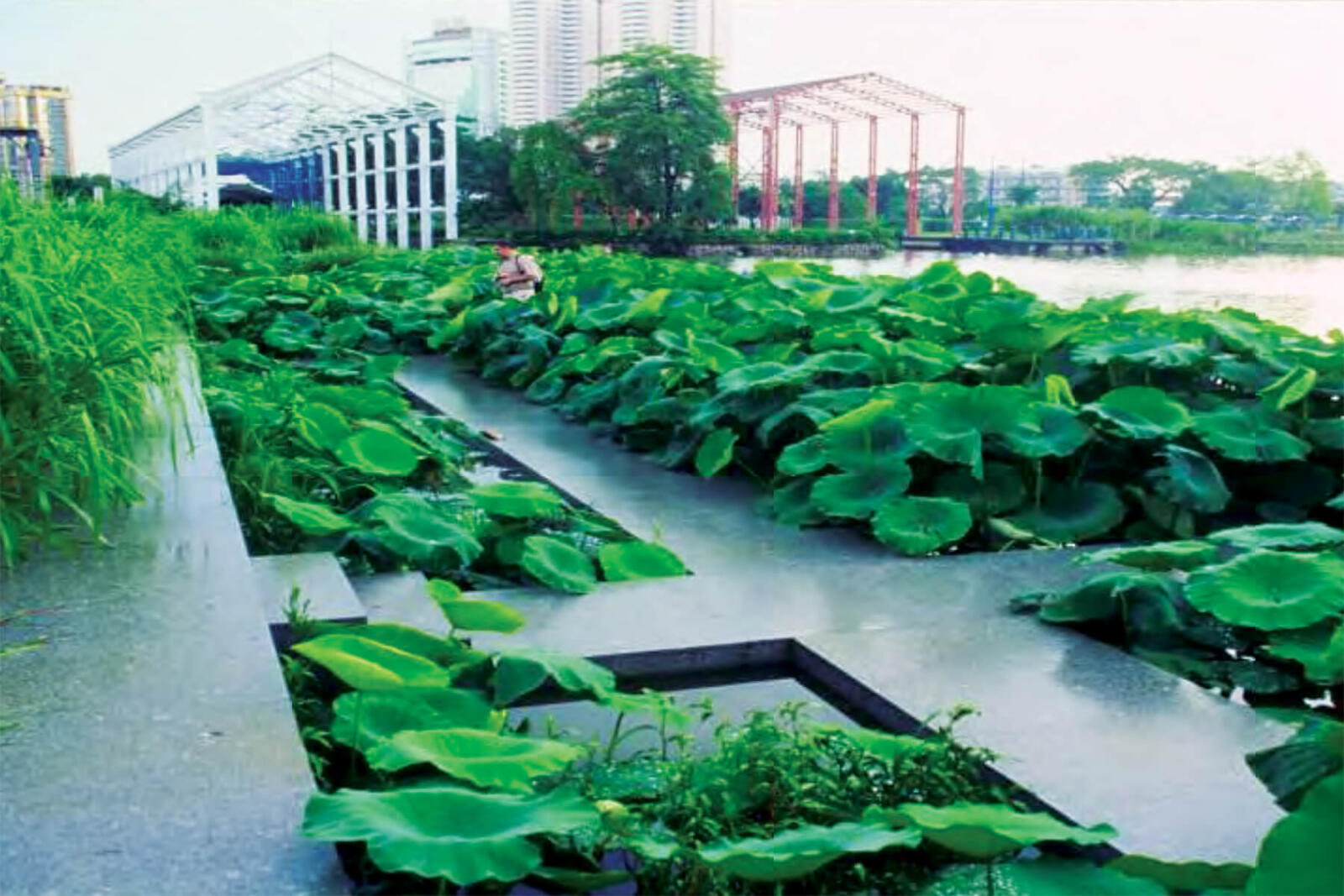January 15, 2014

Designed ecologies by Dr. Yu are wild and beautiful. Skywalks allow pedestrians to access the landscape.
Healing the landscape with designed ecologies
By Sarah Willis
Ryerson University hosted a special evening presentation on Dec. 3 by Dr. Kongjian Yu, dean of Peking University and principal designer at his 600-person design firm, Turenscape.
The room was packed for the evening lecture, in testament to the inspirational and innovative landscapes designed by the man Time magazine calls, “A force of nature.”
Dr. Yu began by speaking about the explosive growth China has experienced in the past two decades. In order to accommodate escalating population densities in rapidly-growing cities, planners have engineered rivers and vast kilometres of grey infrastructure, creating polluted waterways and smog-filled corridors. He said that China is going after the “American jumbo dream” of supersizing buildings and infrastructure, when the country has meagre renewable resources, and can’t afford to produce large, inefficient structures.
Dr. Yu showed examples where the Chinese have turned messy, rural, productive landscapes into unproductive, urban gardens in their attempt to attain gentrification. “Beautiful uselessness,” he called it.
“Grey infrastructure is actually destroying the natural system, along with its resilience and capacity of providing free services that humanity needs,” said Dr. Yu. His ground-breaking designs use ecological (green) infrastructure to produce a landscape that is life-supporting and spiritual, as well as providing sustainable ecosystems that clean the air and water, and heal the land.
Dr. Yu showed examples of his projects which bust-up the concrete engineered water channels and use natural storm water management treatments and biodiversity. He begins with an evaluation of the land’s natural storm water retention capacity, and integrates green elements and infrastructure to develop a landscape security pattern for towns and cities.
 A park in the old Zhongshan Shipyard reuses existing structures in a natural design that allows for seasonal changes in water levels.
A park in the old Zhongshan Shipyard reuses existing structures in a natural design that allows for seasonal changes in water levels.
Throughout China, Dr. Yu is taking down concrete dykes and building biological ones, showing the Chinese government there are solutions to flood control beyond engineering. His approach is to leave flood plains untouched and resilient. His parks are wild, messy, yet beautiful, and productive; often incorporating rice paddies, sorghum and fields of sunflowers along with skywalks and meeting places for residents and birdwatchers.
Getting China’s mayors and bureaucrats to see the benefits of his landscape plans is part and parcel of Dr. Yu’s work. Gradually, he is helping to change the mentality of city planners, showing them how they can help nature to recover and let nature do the work of grey infrastructure. Dr. Yu’s design intent can be summed up as, “minimize intervention and maximize return.”
Anyone who missed the lecture, but is interested in learning more about the landscapes of Dr. Kongjian Yu, can purchase the book of his work Designed Ecologies, by William Saunders.
Ryerson University hosted a special evening presentation on Dec. 3 by Dr. Kongjian Yu, dean of Peking University and principal designer at his 600-person design firm, Turenscape.
The room was packed for the evening lecture, in testament to the inspirational and innovative landscapes designed by the man Time magazine calls, “A force of nature.”
Dr. Yu began by speaking about the explosive growth China has experienced in the past two decades. In order to accommodate escalating population densities in rapidly-growing cities, planners have engineered rivers and vast kilometres of grey infrastructure, creating polluted waterways and smog-filled corridors. He said that China is going after the “American jumbo dream” of supersizing buildings and infrastructure, when the country has meagre renewable resources, and can’t afford to produce large, inefficient structures.
Dr. Yu showed examples where the Chinese have turned messy, rural, productive landscapes into unproductive, urban gardens in their attempt to attain gentrification. “Beautiful uselessness,” he called it.
“Grey infrastructure is actually destroying the natural system, along with its resilience and capacity of providing free services that humanity needs,” said Dr. Yu. His ground-breaking designs use ecological (green) infrastructure to produce a landscape that is life-supporting and spiritual, as well as providing sustainable ecosystems that clean the air and water, and heal the land.
Dr. Yu showed examples of his projects which bust-up the concrete engineered water channels and use natural storm water management treatments and biodiversity. He begins with an evaluation of the land’s natural storm water retention capacity, and integrates green elements and infrastructure to develop a landscape security pattern for towns and cities.
 A park in the old Zhongshan Shipyard reuses existing structures in a natural design that allows for seasonal changes in water levels.
A park in the old Zhongshan Shipyard reuses existing structures in a natural design that allows for seasonal changes in water levels.
Throughout China, Dr. Yu is taking down concrete dykes and building biological ones, showing the Chinese government there are solutions to flood control beyond engineering. His approach is to leave flood plains untouched and resilient. His parks are wild, messy, yet beautiful, and productive; often incorporating rice paddies, sorghum and fields of sunflowers along with skywalks and meeting places for residents and birdwatchers.
Getting China’s mayors and bureaucrats to see the benefits of his landscape plans is part and parcel of Dr. Yu’s work. Gradually, he is helping to change the mentality of city planners, showing them how they can help nature to recover and let nature do the work of grey infrastructure. Dr. Yu’s design intent can be summed up as, “minimize intervention and maximize return.”
Anyone who missed the lecture, but is interested in learning more about the landscapes of Dr. Kongjian Yu, can purchase the book of his work Designed Ecologies, by William Saunders.